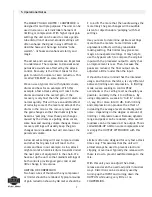
7
5. Operational Notes
The MANLEY NU MU LIMITER / COMPRESSOR is
designed for multiple purposes. The unit can be
used in stereo or as 2 individual channels of
limiting or compression. With higher input gain
settings the unit can be used to create gentle
tube distortion if desired. Modest settings will
often enhance the signal in ways difficult to
describe however the range includes "tube
warmth", richness and enhanced clarity and
magic.
The attack and recovery controls are important
to understand. The response to transients and
percussive sounds are affected by the attack
control. Recovery is the time it takes for the
gain to return to normal or zero reduction. This
is called "RELEASE" on some limiters.
We can use a typical mix with dynamic vocals,
drums and bass for an example. With this
example a fast attack setting will react to the
drums and reduce the overall gain. If the
recovery is very fast then the gain will return to
normal quickly. This will have an audible effect
of reducing some of the level and attack of the
drums in the mix. As the recovery is set slower
the gain changes so that the drums might be
heard as "pumping". Now these gain changes
caused by the drums are pulling down vocals,
some bass and causing volume changes. Slower
recovery settings will usually keep the gain
changes more inaudible but will also lower the
perceived volume.
A slow attack setting will tend to ignore drums
and other fast signals but will react to the
vocals and bass in our example. A slow attack
might also let a hard kick drum transient distort
the next piece of equipment in the chain. We
have set up the unit so that medium settings of
both controls provide good gain control and
little change in mix values.
LIMITING OR COMPRESSION
Two basic rules of thumb with any compressor
or limiter should be reminded. Typical amounts
of gain reduction shown by GR meter should be
2 to 6 dB. The more that the needle swings the
more likely the gain changes will be audible.
Listen for objectionable "pumping" with fast
settings.
Use your ears to determine optimum settings
more than the meters. Some limiters add
unpleasant artifacts with any reasonable
looking setting. This limiter may give some
magic at unexpected settings. It may help to
use the bypass switch to compare the original
input with the processed output to verify that
an improvement is real. Then, because the
peaks are reduced, the final output can be
adjusted a little louder than the input.
It should be borne in mind that the intended
usage, and function therefore, is very different
between limiting and compression. In limiting
mode we are seeking to control PEAK
overshoots or the 'ceiling' level as inaudibly as
possible, normally in the 2 to 4 dB area. By
using compression we seek to "fold in" a ratio
of, say, 20 or more into 10 dB. Both limiting
and compression can produce the effect of
increasing the average levels and background
noise - depending on the degree or amount of
limiting / compression used. Because dynamic
range and peaks can be reduced, often overall
loudness can be increased at the output. This is
called MAKE-UP GAIN on some compressors and
is simply the OUTPUT ATTENUATOR with this
unit.
Limiters often are designed for very fast attack
times only. This assumes that the unit will
almost always be used to prevent electronic
clipping or overload. Typically the release with
these is slow to prevent audible damage to the
mix.
With this unit you can adjust the attack,
release and even the overload point in musical
ways. Distortion can be creatively used by
turning up the INPUT and turning down the
OUTPUTs while using very little or no
COMPRESSION.
n u
u
m
n u
u
m




































